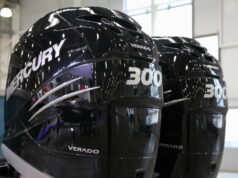Choosing the right propulsion system is critical when investing in a new boat or updating an existing one. This decision not only affects the boat’s performance but also its maintenance, longevity, and value. The two primary types of marine engines to consider are inboard and outboard motors. To make an informed choice, let’s delve into the pros and cons of each option.
Inboard Motors
Inboard motors, as the name suggests, are engines installed within the hull of the boat. They drive a fixed propeller via a driveshaft and are typically located in the center of the boat to optimize balance.
Pros of Inboard Motors
- Better Balance and Stability: The centralized placement of the inboard engine contributes to better weight distribution and balance, providing increased stability, particularly in rough waters. This can lead to a smoother and more comfortable ride.
- Maneuverability: Twin inboard motors offer superior maneuverability because they can be controlled independently, allowing for complex maneuvers like pivoting in place.
- Durability: Inboards are typically more durable and have a longer lifespan than outboards. They are also more suited to handle larger boats and deliver higher horsepower, making them ideal for speed boats, yachts, and other large vessels.
Cons of Inboard Motors
- Maintenance and Repair: Maintenance and repairs can be more difficult and costly due to the inboard motor’s internal location. Special equipment or professional assistance is often required.
- Fuel Efficiency: Inboards tend to consume more fuel than outboard motors, making them less economical for regular or long-distance boating.
- Draft: Due to the fixed propeller position, inboards need deeper water to avoid damaging the hull or propeller on underwater obstacles.
Outboard Motors
Outboard motors, conversely, are located outside the boat’s hull at the stern. They are self-contained units that include an engine, gearbox, and propeller.
Pros of Outboard Motors
- Ease of Maintenance and Repair: Outboards are easier to access for maintenance and repairs. They can even be completely removed for major overhauls or replacements.
- Fuel Efficiency: Modern outboard motors are quite fuel-efficient, especially the four-stroke varieties, making them economical for recreational boating.
- Versatility and Performance: Outboards can be tilted up out of the water when not in use, reducing drag and enabling navigation in shallow waters. They also provide a good power-to-weight ratio, enhancing speed and performance.
Cons of Outboard Motors
- Lifespan: Outboard motors generally have a shorter lifespan than inboard motors due to exposure to harsh marine elements.
- Noise and Vibration: Outboards tend to be noisier and cause more vibration than inboards, which can impact the boating experience, particularly on longer journeys.
- Aesthetics: From a visual perspective, outboard motors are more visible and may not be as aesthetically pleasing as the hidden inboard alternatives.
In conclusion, the choice between inboard and outboard motors ultimately depends on your specific boating needs and preferences. If you prioritize fuel efficiency, ease of maintenance, and versatility, an outboard motor could be your best choice. However, if your focus is on power, durability, and stability, an inboard motor might be the way to go. Always remember to consider these pros and cons carefully to ensure you make the best decision for your boating lifestyle.






